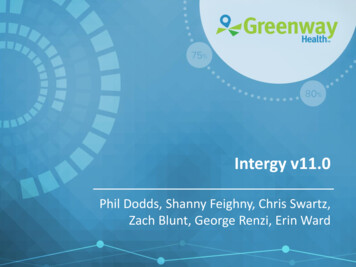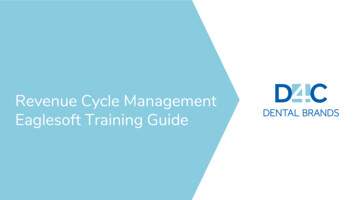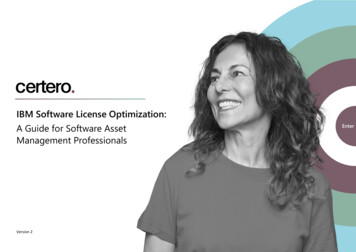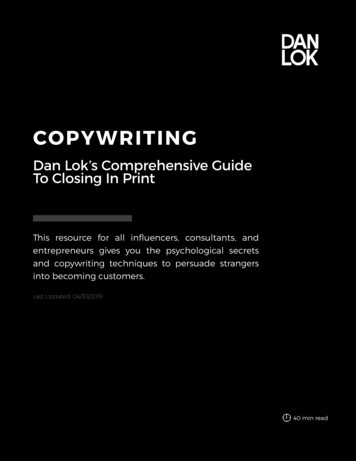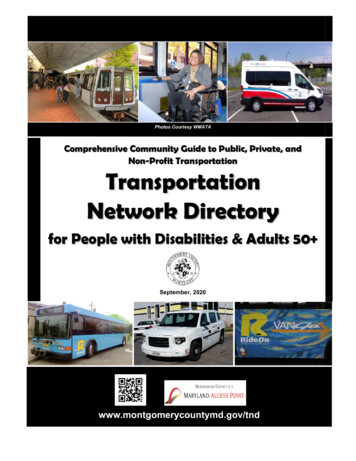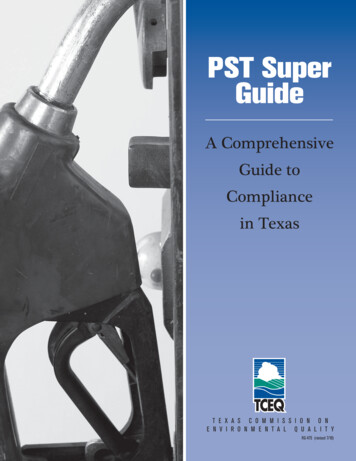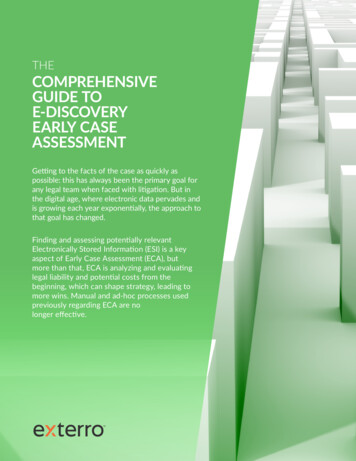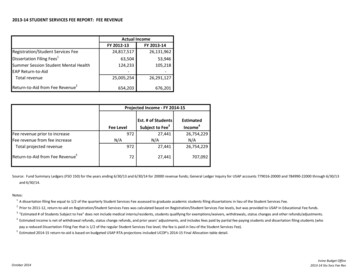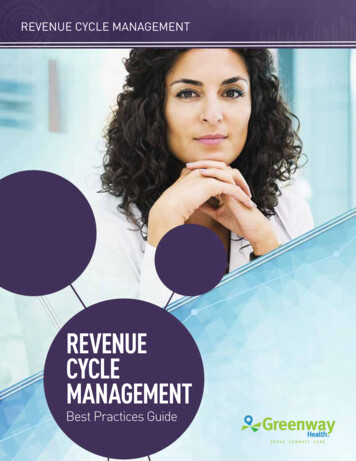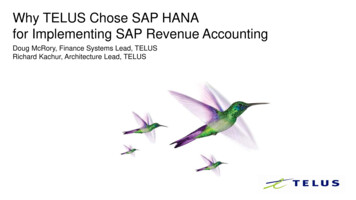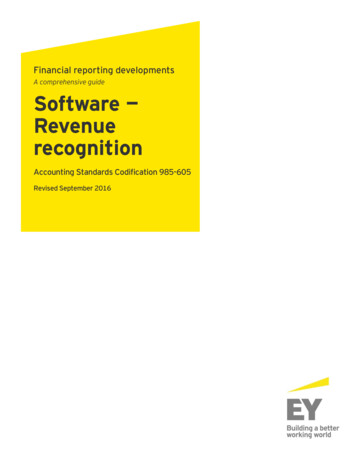
Transcription
Financial reporting developmentsA comprehensive guideSoftware —RevenuerecognitionAccounting Standards Codification 985-605Revised September 2016
To our clients and other friendsDetermining how and when to recognize revenue for software licensing arrangements continues to bechallenging even though it has been more than a decade since the Accounting Standards ExecutiveCommittee (AcSEC) of the American Institute of Certified Public Accountants (AICPA) issued Statementof Position 97-2, Software Revenue Recognition.1 This guidance is codified in the Accounting StandardsCodification (ASC) at 985-605, Software — Revenue Recognition. This publication has been updated toinclude the appropriate references from the ASC.We have prepared this publication to help you understand and apply the software revenue recognitionaccounting literature. This publication presents each paragraph (or series of paragraphs) excerpted fromthe ASC verbatim. These excerpts are followed by a discussion of our current views and observations onthe application of the guidance. These discussions utilize questions and responses, including illustrativeexamples, to highlight key concepts. Our views and observations are based on the relevant guidance,what we have seen in practice, consultations with the standards setters, interactions with other majoraccounting firms and our participation on the Software Revenue Recognition Task Force, a once-standingtask force of AcSEC.2In October 2009, the Financial Accounting Standards Board (FASB) issued Accounting Standards UpdateNo. 2009-14, Certain Revenue Arrangements that Include Software Elements (ASU 2009-14), that willsignificantly affect how entities account for revenue arrangements containing both hardware andsoftware elements. ASU 2009-14 revised the guidance regarding the types of arrangements that fallunder the scope of the software revenue recognition guidance, providing a scope exception for manytransactions that were previously within the scope of ASC 985-605.This publication has been updatedto reflect the revised scope exceptions to the software revenue recognition guidance provided byASU 2009-14, and it provides guidance on certain transition issues entities are likely to encounter.We expect software revenue recognition to continue to present challenges for financial statementpreparers. Ways of doing business continue to evolve as do the views of the standard setters andregulators. While these changes are inevitable, one thing is certain — it is imperative that any companyrequired to apply the software revenue recognition standards be thoroughly knowledgeable of theguidance and have robust and effective processes and controls to facilitate and maintain compliancetherewith. We hope this publication will help you understand and successfully apply the provisions ofASC 985-605. Ernst & Young professionals are prepared to assist you in your understanding and areready to discuss your particular concerns and questions.September 201612As amended by Statement of Position 98-9, Modification of SOP 97-2, Software Revenue Recognition, With Respect to CertainTransactionsThe Task Force commenced in 1998 and is now largely inactive.
Contents1Introduction and scope . 11.11.21.32Relationship to other pronouncements . 262.13Chapter summary . 26Basic principles. 373.13.23.33.43.53.63.73.83.94Chapter summary . 1Introduction and scope . 2Scope exceptions . 14Chapter summary . 37Arrangements to customize licensed software. 37Basic revenue recognition criteria . 38Multiple-element arrangements . 38Allocating fees based on VSOE of fair value . 39Allocating discounts . 50Revenue recognition for bundled units of accounting . 53Undelivered elements essential to functionality of delivered elements . 66Fees subject to forfeiture, refund or concession . 68Basic principles recognition criteria . 754.14.24.34.44.54.64.74.84.94.10Chapter summary . 75Persuasive evidence of an arrangement . 75Delivery has occurred . 88Customer acceptance . 104Multiple copies of software products versus multiple licenses . 113Delivery other than to the customer. 115Delivery agents . 116Authorization codes . 117The vendor’s fee is fixed or determinable and collectibility is probable . 122Factors that affect the determination of whether a fee is fixed ordeterminable and collectible. 1324.11 Reseller arrangements . 1644.12 Customer cancellation privileges. 1724.13 Fiscal funding clauses. 1755Multiple-element arrangements . 1775.15.25.35.45.55.6Chapter summary . 177Identifying elements in multiple-element arrangements . 178Upgrades or enhancements . 205Additional software products . 221Price-per-copy arrangements . 226Unspecified additional software products . 231Financial reporting developments Software — Revenue recognition i
1 Introduction and scope6Rights to exchange or return software . 2366.16.26.37Postcontract customer support . 2647.17.27.37.47.57.68Chapter summary . 264Services that qualify as PCS . 265VSOE of fair value of PCS . 272Upfront recognition of PCS . 308Postdelivery telephone support at no additional charge . 311Reseller PCS . 312Services . 3148.18.28.38.48.59Chapter summary . 236Platform-transfer rights . 252Exchange rights provided to resellers. 259Chapter summary . 314Determining if services can be accounted for as a separate element in the arrangement. 314Allocating and recognizing revenue for a separate service element . 321Core software versus off-the-shelf software . 327Funded software-development arrangements . 334Contract accounting. 3419.19.29.39.49.59.69.7Chapter summary . 341Contract accounting. 342Applying contract accounting to software arrangements . 353Combining and segmenting contracts . 360Applying the percentage-of-completion method to software arrangements . 367Input measures . 373Output measures . 37610 Disclosures . 37810.1 Chapter summary . 37810.2 Management’s Discussion and Analysis . 379A Transitional considerations in adopting the revised guidance in ASU 2009-14 . A-1A.1A.2Chapter summary .A-1Transition and effective date .A-2B Abbreviations used in this publication . B-1C Index of ASC references in this publication . C-1D Relationship to other pronouncements . D-1D1Introduction and scope . D-2D1.1Chapter summary . D-2D1.2Introduction and scope . D-2D2Relationship to other pronouncements.D-20D2.1Chapter summary .D-20EList of FAQs . E-1Financial reporting developments Software — Revenue recognition ii
1 Introduction and scopeNotice to readers:This publication includes excerpts from and references to the FASB Accounting Standards Codification(the Codification or ASC). The Codification uses a hierarchy that includes Topics, Subtopics, Sectionsand Paragraphs. Each Topic includes an Overall Subtopic that generally includes pervasive guidance forthe topic and additional Subtopics, as needed, with incremental or unique guidance. Each Subtopicincludes Sections that in turn include numbered Paragraphs. Thus, a Codification reference includes theTopic (XXX), Subtopic (YY), Section (ZZ) and Paragraph (PP).Throughout this publication references to guidance in the codification are shown using these referencenumbers. References are also made to certain pre-codification standards (and specific sections orparagraphs of pre-Codification standards) in situations in which the content being discussed is excludedfrom the Codification.This publication has been carefully prepared but it necessarily contains information in summary form andis therefore intended for general guidance only; it is not intended to be a substitute for detailed researchor the exercise of professional judgment. The information presented in this publication should not beconstrued as legal, tax, accounting, or any other professional advice or service. Ernst & Young LLP canaccept no responsibility for loss occasioned to any person acting or refraining from action as a result ofany material in this publication. You should consult with Ernst & Young LLP or other professionaladvisors familiar with your particular factual situation for advice concerning specific audit, tax or othermatters before making any decisions.Portions of FASB publications reprinted with permission. Copyright Financial Accounting Standards Board, 401 Merritt 7, P.O.Box 5116, Norwalk, CT 06856-5116, U.S.A. Portions of AICPA Statements of Position, Technical Practice Aids, and other AICPApublications reprinted with permission. Copyright American Institute of Certified Public Accountants, 1211 Avenue of the Americas,New York, NY 10036-8775, USA. Copies of complete documents are available from the FASB and the AICPA.Financial reporting developments Software — Revenue recognition iii
1Introduction and scope1.1Chapter summaryIn October 1997, the AcSEC of the AICPA issued Statement of Position 97-2, Software RevenueRecognition (SOP 97-2). This guidance is codified in ASC 985-605, Software — Revenue Recognition.The guidance in ASC 985-605 is applicable to transactions involving the licensing, selling, leasing orotherwise marketing of computer software and related elements. This guidance requires a determinationof its applicability to revenue arrangements at an activity level versus an entity level (i.e., whether or notan entity is a software entity in the traditional vernacular is not determinative in assessing whether atransaction is or is not within the scope of ASC 985-605). In certain circumstances, the assessment as towhether an arrangement is within the scope of ASC 985-605 can be straightforward. However, thisassessment can also be complex and require considerable professional judgment, especially when thesoftware is bundled with products, services or both.Additionally, if an entity offers discounts or other concessions relating to software products or otherdeliverables that are within the scope of ASC 985-605 that are determined to be “more-than-insignificant,”an additional element is being offered in the arrangement, and that element also must be accounted for inaccordance with ASC 985-605. However, insignificant discounts and discounts that are not incremental todiscounts typically given in comparable transactions are not unique to software transactions and are notincluded in the scope of ASC 985-605. These types of discount offers are similar to coupons offered in aretail environment for mass marketing efforts. This guidance also applies to certain hosting arrangementsand to the sale of services containing or utilizing software when the software content is more-thanincidental to the service and the service is essential to the functionality of the software.However, the guidance also contains a number of scope exceptions for certain elements in an arrangement.Specifically, the following types of transactions have been excluded from the scope of this guidance: Arrangements in which the software is incidental to the products or services as a whole. Leases of software that include a tangible product, if the software is incidental to the tangibleproduct as a whole or the software and nonsoftware components of the tangible product functiontogether to deliver the tangible product’s essential functionality. Nonsoftware components of tangible products. Software components of tangible products when the software components and nonsoftwarecomponents of the tangible product function together to deliver the tangible product’s essentialfunctionality. We also refer to these types of software components as “essential software”throughout this publication. Undelivered components that relate to the software that is essential to the above-described tangibleproduct’s functionality.These concepts are discussed further below.Financial reporting developments Software — Revenue recognition 1
1 Introduction and scope1.2Introduction and scopeExcerpt from Accounting Standards CodificationSoftware — Revenue RecognitionOverview and Background985-605-05-1This Subtopic provides guidance on when revenue should be recognized and in what amounts forlicensing, selling, leasing, or otherwise marketing computer software.985-605-05-2[Not used]985-605-05-3Software arrangements range from those that provide a license for a single software product to thosethat, in addition to the delivery of software or a software system, require significant production,modification, or customization of software.985-605-05-4Structurally, the form of a hosting arrangement may be split into two elements:a.The right to use softwareb.The hosting service.The arrangement may or may not include a license right to the software and the customer may or maynot have an option to take delivery of the software. The guidance beginning in paragraph 985-605-55119 addresses the scope application of this Subtopic to a hosting arrangement.Scope and Scope Exceptions985-605-15-1This Subtopic follows the same Scope and Scope Exceptions as outlined in the Overall Topic, seeSection 985-10-15, with specific qualifications and exceptions noted below.985-605-15-2The guidance in this Subtopic applies to all entities.985-605-15-3The guidance in this Subtopic applies to the following transactions and activities:a.Licensing, selling, leasing, or otherwise marketing computer software.b.[Subparagraph superseded by Accounting Standards Update No. 2009-14]c.The software and software-related elements of arrangements that include software that is more
This guidance is codified in ASC 985-605, Software — Revenue Recognition. The guidance in ASC 985-605 is applicable to transactions involving the licensing, selling, leasing or otherwise marketing of computer software and
